 The first step in education ever made by the Feminine mind was the art of Needlework…….
The first step in education ever made by the Feminine mind was the art of Needlework…….
Enjoy these excerpts from “The Ladies Complete Guide to Crochet & Fancy Knitting pub:1854″ Come on a journey where we peek behind the lace curtain of these extraordinary women and the lives they lived.
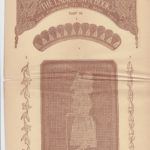
EXCERPT #8
December 11, 2017
The patterns contained in this book are printed on legal size paper that is so delicate, each are folded and folded again, then placed in an envelope that is attached to the inner cover. Some are printed in green ink and others brown like the one I have included here. I ever so carefully unfolded it, scanned it and placed it back in the book!
If you look carefully you can see the grid design for Punch’s Anti-Macassar. I’ve seen this design before, I don’t find it very intriguing to make but it must have been very popular to make it into this book.
The definition of Anti-Macassar is just a small cloth placed over the backs or arms of chairs, or the head or cushions of a sofa, to prevent soiling of the permanent fabric.
If you collect vintage patterns you will find hundreds of designs for the sole purpose of covering everything!
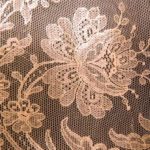 EXCERPT #7
EXCERPT #7
November 11, 2017
Ann continues her sometimes lengthy conversation about Crochet and a variety of other trending techniques past and present. One such explanation is the Historical mention of “Chantilly Blonde Lace“.
I have heard about Chantilly Lace but really didn’t know its history as imbeded with other “laces of this era”. Although Caen and Bayeux were the principle blonde manufacturers in France, a variety originated out of the town of Chantilly. Their lace was to a higher perfection than any other and was proportionably higher in price. Chantilly Lace was extensively worn in England thirty years before this precious book was written and is already traditional if waning by 1854.
Chantilly Lace is a rich close pattern, contrasting with the filmy lightness of the ground. It was chiefly woven for veils thrown over the wearer bonnet or shoulders.
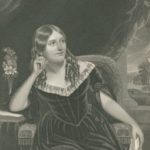
EXCERPT #6
August 19, 2017
I thought you might like to meet the author herself a.k.a. “Jonathan Slick” and learn a little more about this woman who can only be described as “modern” for her time! She looks so young to me in this picture.
Ann Sophia Winterbotham was born on March 30, 1810 in Derby, Connecticut. She began her writing career at a very early age, marrying a printer Mr. Edward Stephens from Plymouth, Massachusetts. She would later be credited for the “dime novels” that she wrote. In her spare time as auther and editor and publicist of her own magazine, she must have written, printed and published this lovely book in 1854 “The Ladies Complete Guide to Crochet and Fancy Knitting”. In 1855 a “Portfolio of Fancy Needlework”, would sure like to find that too!
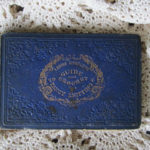 A little book of Crochet date: 1854
A little book of Crochet date: 1854
I acquired this book from my Grandmother Selma Ackerman Buker. I do not know when she acquired it nor whether or not she ever crocheted or knitted any of the pattern collections included in it. It is extremely fragile as you might expect any book from 1854.
Also, crochet pattern writing has changed in the One hundred-sixty three years of its publishing. See an excerpt below:
NET FOR THE HAIR
Materials – Three good skeins of scarlet or blue netting silk; elastic ribbon and tassels to correspond; crochet hook, No. 12.
Make 6 chain, and form them into a round.
1st. – 1 tc. into every chain, and 1 ch., after every tc., thus making 12 stiches in the round.
2nd. – 1 tc. on one chain, 3 ch., miss tc. stitch.
Repeat.
3rd. – X 1 tc. on the centre of the loop, 5 ch. X repeat.
4th. – X 1 tc. on centre of loop, 7 ch. X repeat.
5th to 10th rounds inclusive. – Like the last, increasing two chain at every round, so that 9 ch. are made in th 5th, and 19 in the 10th round.
11th. – 3 tc., 3 ch., miss 3. Repeat
12th. – X 3 tc. on 3 ch., 3 ch., miss 3, + repeat.
13th. – X 4 tc., 4 ch., miss 4, X repeat.
14th. – + 4 tc. on 4 ch., 5 ch., miss 4, + repeat.
The elastic ribbon is to be run in the 11th round, and tassels fastened to hang over the ear.
PLEASE send me a pic of your finished work for all to see!
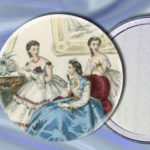 EXCERPT #5
EXCERPT #5
July 09, 2017
I have my own thoughts to share on these passages. At times reading what the writer has written I feel them not written by a woman at all, but sentiments of a man. Did women of this time “1854” feel the same way towards each other?
Read more…….On no occasion does a lady seem more lovely than when half occupied with some feminine art which keeps her fingers employed, and gives an excuse for downcast eyes and gentle pre-occupation. This sort of playing at work, and working at play, sheds a home feeling around the guests which no studied effort at hospitality can produce, and forms habits of usefulness which consumes many an hour of idle time that might be put to far more harmful uses.
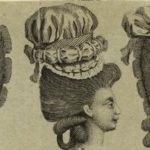 EXCERPT #4
EXCERPT #4
July 01, 2017
How rude and uncouth these first attempts were, matters little. They constituted the alphabet of all the bright creations, whether of the pencil or pen, which are the glory of the present century. During the Dark Ages Needlework was considered an aristocratic, nay, almost a regal accomplishment, and queens vied with each other in the gentle art as ardently as their husbands struggled in the battlefield.
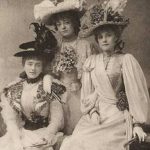 EXCERPT #3
EXCERPT #3
June 27, 2017
Taking a hint from the flowers, God’s own handwriting of love upon the bosom of the earth, woman began to symbol the deep feelings of her nature in imperfect imitations, and this was the first step made by woman in the progress of mind.
Of course, I think it all started with the hats!
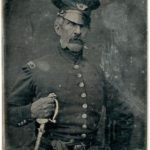 EXCERPT #2
EXCERPT #2
June 15, 2017
In olden times, when war and warlike fame was the great object of every brave man…..woman embroidered scarfs and war pennants that were worn by the sterner sex as rewards of valor or expressions of love.

EXCERPT #1
May 01, 2017
Before women began to read, and when they considered writing as a mystery only to be undertaken by men of nobler parts, Needlework became a sort of medium by which women attempted to express their ideas and embody those affectionate thoughts that must have some expression to keep the full heart from overflowing.
![]()